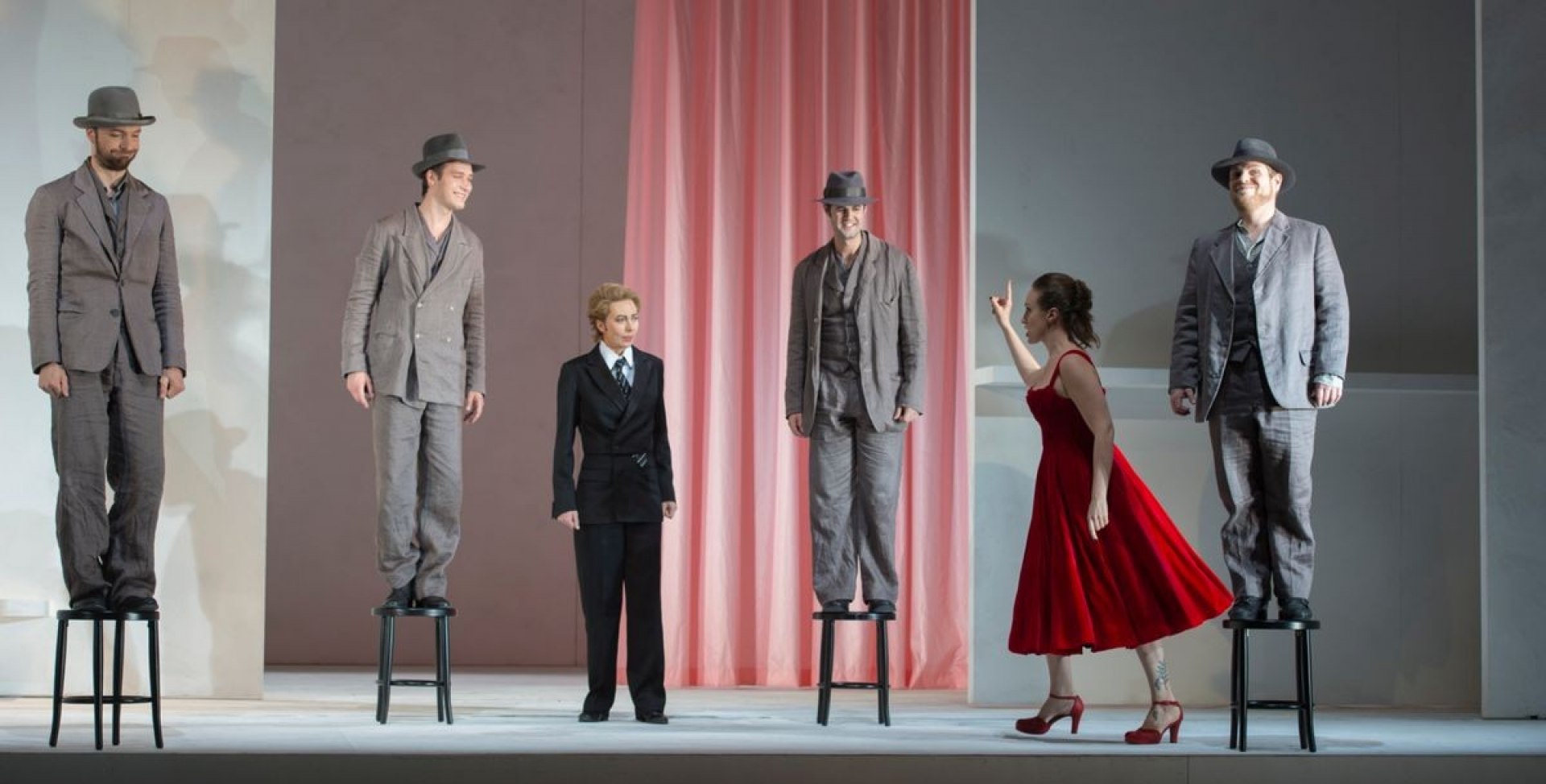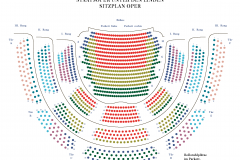Ariadne on Naxos
April 2026 | ||||||
|---|---|---|---|---|---|---|
Mo | Tu | We | Th | Fr | Sa | Su |
Ariadne on Naxos
Opera in a prologue and one act (1916)
Music by Richard Strauss
Libretto by Hugo von Hofmannsthal
Duration: Approximately 2 hours and 30 minutes, including one intermission after Act I
Language: Performed in German with surtitles
Recommended Age: Suitable for ages 14 and up
Few operas have more to say about remaining true (to yourself) in matters of art and love than Ariadne auf Naxos: should you cling to the one you love unconditionally, or remain open to new loves?
Just before a young composer’s new opera is about to be premiered, he learns that the wealthy but philistine patron who commissioned the piece wishes to make some last-minute changes. His heroic opera about Ariadne, tormented by lost love and yearning for death, must be performed at the same time as a piece by a burlesque troupe. In line with the patron’s wishes (and against the composer’s will), the carefree Zerbinetta and her suitors are inserted into the Ariadne opera. The result, as Richard Strauss’s librettist Hugo von Hofmannsthal described it, is a "juxtaposition between the woman who only loves once and the one who gives herself many times". Through the archetypal opera characters, a confrontation is staged between two different models of love and life that is sometimes humorous and playful, sometimes serious. The work also reflects on artistic questions such as the coexistence of comedic and dramatic elements in opera, and transports the audience into the turbulent events behind the scenes of a fictional opera premiere.
Synopsis
Ariadne auf Naxos is in two parts, called the Prologue and the Opera. The first part shows the backstage circumstances leading up to the second part, which is in fact an opera within an opera.
Prologue
At the home of the richest man in Vienna, preparations for an evening of music are under way. Two troupes of musicians and singers have arrived. One is a burlesque group, led by the saucy comedienne Zerbinetta. The other is an opera company, who will present an opera seria, Ariadne auf Naxos, the work of the Composer. Members of the two companies quarrel over which performance should be presented first. However, the preparations are thrown into confusion by an announcement by the Major-domo. The dinner for the assembled guests has run longer than planned. Therefore, both performances must take place at the same time as they have been ordered and paid for. The performances must not run one minute later than scheduled, despite the late start, since at nine o'clock there will be fireworks in the garden.
At first, the impetuous young Composer refuses to discuss any changes to his opera. But his teacher, the Music Master, points out that his pay depends on accepting the situation, and counsels him to be prudent, and Zerbinetta turns the full force of her charm on him, so he drops his objections. The cast of the opera seria intrigue against each other, each demanding that his arias be not cut while the other performers' parts are cut instead. A dancing master introduces Zerbinetta into the plot, which she understands from her very own perspective, and she gets ready for the performance. The Composer realizes what he has assented to, plunges into despair and storms out.
Opera
Ariadne is shown abandoned by her former lover, Theseus, on the desert island of Naxos, with no company other than the nymphs Naiad, Dryad, and Echo. Ariadne bewails her fate, mourns her lost love, and longs for death. Zerbinetta and her four companions from the burlesque group enter and attempt to cheer Ariadne by singing and dancing, but without success. In a sustained and dazzling piece of coloratura singing, Zerbinetta tells the Princess to let bygones be bygones and insists that the simplest way to get over a broken heart is to find another man. In a comic interlude, each of the clowns pursues Zerbinetta. Eventually, she chooses Harlequin, a baritone, and the two sing a love duet together while the other clowns express frustration and envy.
The nymphs announce the arrival of a stranger on the island. Ariadne thinks it is Hermes, the messenger of death, but it is the god Bacchus, who is fleeing from the sorceress Circe. At first they do not understand their mistaken identification of each other. Bacchus eventually falls in love with Ariadne, who agrees to follow him to the realm of death to search for Theseus. Bacchus promises to set her in the heavens as a constellation. Zerbinetta returns briefly to repeat her philosophy of love: when a new love arrives, one has no choice but to yield. The opera ends with a passionate duet sung by Ariadne and Bacchus.
Program and cast
Musical Director: Eun Sun Kim
Director: Hans Neuenfels
Set Design: Katrin Lea Tag
Costumes: Andrea Schmidt-Futterer
Light: Stefan Bolliger
Der Haushofmeister: Max Urlacher
Ein Musiklehrer: Roman Trekel
Der Komponist: Katharina Kammerloher
Primadonna, Ariadne: Camilla Nylund
Tenor, Bacchus: Brian Jagde
Zerbinetta: Serena Sáenz
Harlekin: Jaka Mihelač
Scaramuccio: Álvaro Diana
Truffaldin: Manuel Winckhler
Brighella: Junho Hwang
Najade: Sonja Herranen
Dryade: Sandra Laagus
Echo: Serafina Starke
Ein Offizier: Sotiris Charalampous
Ein Perückenmacher: Hanseong Yun
Lakai: David Oštrek
Ein Tanzmeister: Michael Laurenz
Puppenspieler: JARNOTH
Staatskapelle Berlin
State Opera Unter den Linden
Staatsoper Unter den Linden is one of Berlin's most prestigious opera houses, with a rich history and significant cultural impact.
History:
The Staatsoper Unter den Linden was originally built between 1741 and 1743, under the direction of architect Georg Wenzeslaus von Knobelsdorff. It was commissioned by Frederick II of Prussia and was initially named the Königliche Oper (Royal Opera). The opera house has undergone several renovations and reconstructions, notably after World War II damage. It reopened in 1984, following a major renovation.
Construction:
The original design was characterized by its Baroque style, featuring an elegant façade and a grand entrance. The building was reconstructed in the 1950s and 1980s, maintaining its classical exterior while modernizing the interior. The façade features a classic portico with six Corinthian columns and a prominent central pediment.
Interior:
The interior is known for its opulent and classical design. The auditorium is renowned for its acoustics and grandeur, with luxurious velvet seats and elaborate decorations. The stage and seating areas have been updated to meet modern performance standards while preserving historical aesthetics.
Concerts and Performances:
The Staatsoper Unter den Linden hosts a variety of performances, including operas, orchestral concerts, and ballet. It is home to the Staatskapelle Berlin, one of Germany's leading orchestras. The opera house is celebrated for its high-quality productions and its role in Berlin’s vibrant cultural scene.
JOURNEY
The Staatsoper Unter den Linden has completely barrier-free access due to its excellent public transport connections.
ADDRESS: Unter den Linden 7; 10117 Berlin
SUBURBAN RAILWAY
S+U Friedrichstraße (S1, S2, S5, S7, S25, S75)
SUBWAY
Hausvogteiplatz (U2)
Museumsinsel (U5)
Stadtmitte (U2, U6)
Unter den Linden (U5, U6)
BUS
Staatsoper (100, 245, 300)
Unter den Linden/Friedrichstraße (100, 147, 245, 300, N6)
PARKING
Q-PARK parking garage Unter den Linden/Staatsoper
Bebelplatz, 10117 Berlin
There are five electric charging stations in the parking garage. Further information can be found here.
The underground car park on Bebelplatz offers disabled parking spaces and direct access to the opera house. On entering the car park between 5.30pm and 11.30pm, the maximum parking fee is €7. To use this tariff, enter your parking ticket in one of the pay machines and the message »Theatertarif« will appear on the display. Please note that it is not possible to use the tariff if you enter the car park before 5.30pm. so it will not be shown on the display. TIP: If you pay the theatre tariff at the pay machine before the event, you can avoid unnecessary waiting after the show.

 EN
EN DE
DE IT
IT FR
FR ES
ES RU
RU JP
JP RO
RO
 Seating plan
Seating plan 